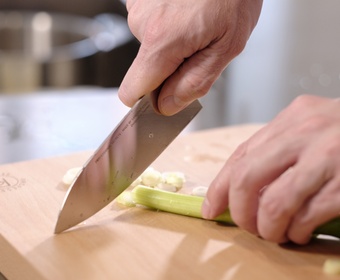The chef’s knife
The kitchen knife is the chef's best friend. It is not only indispensable, it is also personal. Here are some facts about how chef's relate to their knives.
It’s an extension of your body.
– Per Renhed, The Restaurant, F12, and more, about the chef’s personal knife
The right weight
Mass is good. The weight of the knife stabilizes the hand and works in your favor when chopping and cutting.
The right balance
The weight should be balanced across the handle and the blade. With the right grip, the knife should lie comfortably in your hand without tipping in either direction.
The right sharpness
Opinions differ about what is the optimal steel hardness and angle of the knife edge. Harder steel can be made sharper, but is more brittle. An acute angle is sharper, but also more brittle. In the end it’s all about one thing: Your knife should be sharp.
The right cutting board
The board should be relatively soft, for the sake of your knife and for your hand. Different materials have different advantages, but avoid porcelain, glass and hard plastic.
The right knife
If the cutting feels awkward, try a different knife. A longer knife makes cutting easier, a shorter one makes it easier to chop, a small knife enables the chef to attack ingredients from all angles, etcetera. A serrated bread knife should be used only for bread.
The right attitude
A pro wouldn’t even consider working with a dull knife.
The right grip
- Grip your knife like a chef, i e around the upper end of the handle so that your thumb and index finger “pinch” the blade.
- A good technique (there are several) is to rest the tip of the blade on the cutting board while chopping with a rocking, forward motion.
- Flex the fingers on the hand holding the food and guide the blade of the knife with the flat of your nails and/or your knuckles.
Honing and sharpening
When applying a honing steel you are maintaining the sharpness of the blade by realigning it, not actually honing/sharpening it.
Real sharpening
No matter how hard the steel, the knife edge will wear down with frequent use. Become a regular customer of someone who knows how to sharpen knives.
Chop – sharpen – chop – sharpen –
A professional chef uses the honing steel over and over again during a day’s work. For you, it might be enough to use the steel every time you prepare a meal.
- Apply a honing steel regularly. Make it a habit.
- Pull the blade “as if cutting thin slices out of the honing steel”. On both sides, about six to eight times in total.
- Every chef has a personal angle when honing a knife. It is a good idea for the same person to do it every time.
Machine wash or not
Most knives are dishwasher proof. However, after dishwashing you should use the honing steel since particles in the washing liquid may dull the blade.
In a professional kitchen, chef’s knives are sometimes washed in 90°C without washing-up powder to avoid wear on the handle and blade.
Basic knife care
- Preferably hand wash with hot water and washing-up liquid.
- Always dry the knife when not in use.
- Apply a honing steel often. Have your knife sharpened by professionals once in a while.



